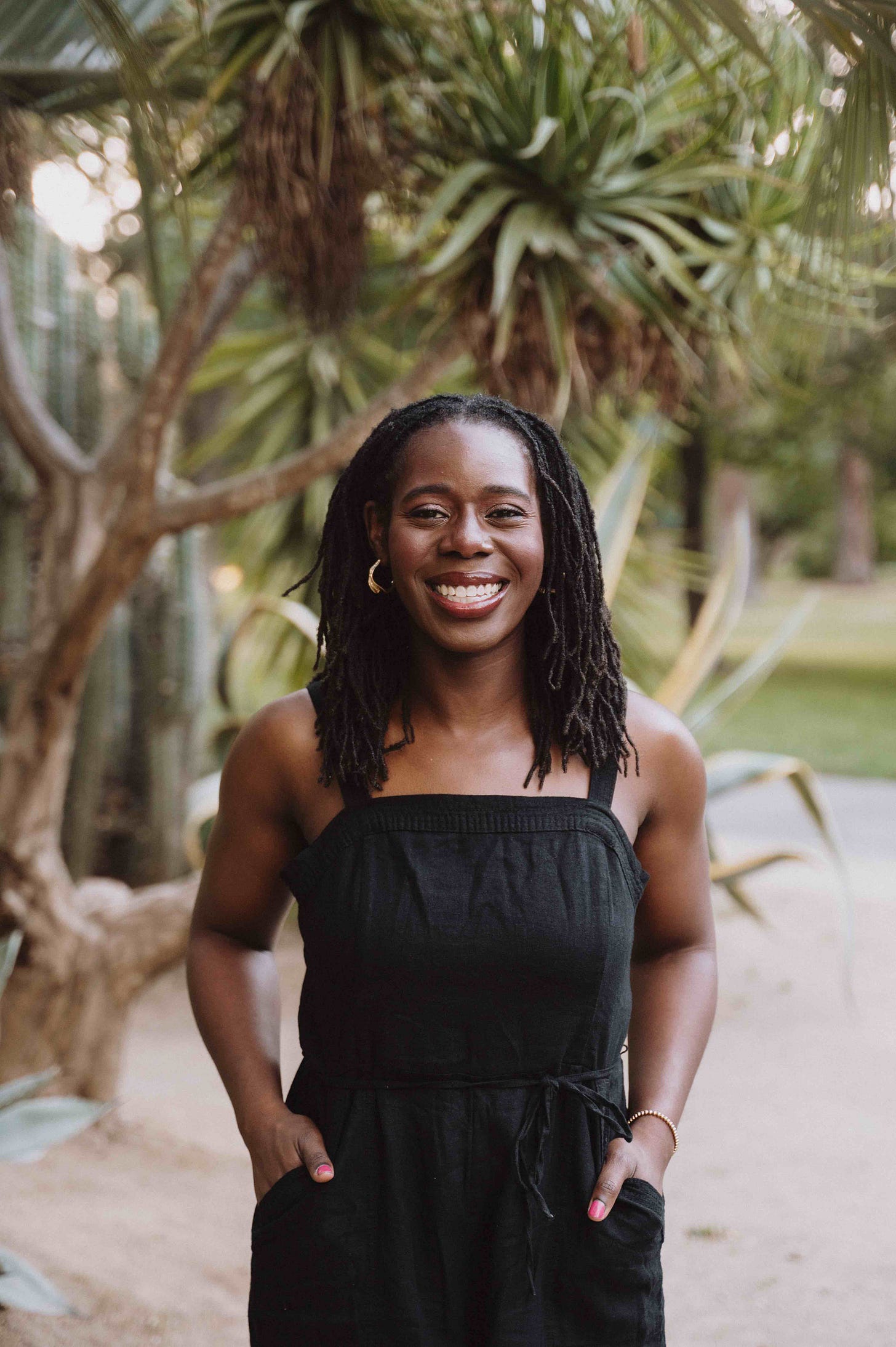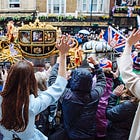Adebola Olayinka Shares How She Will Continue to Watch the Windsors
‘My perspective has shifted from a fan-like follower of the family to a critical observer analyzing the institution.’
Hello! I’m closing out my coronation coverage today with one more guest essay around this major moment in royal history. Adebola Olayinka and I first met on Instagram (of course!); I always look forward to her DMs. Her social media commentary, which spans everything from the British Royal Family to Love is Blind, is informed by her incredibly impressive academic background. She holds a master’s degree in international relations from the University of Chicago as well as a master’s degree and PhD in public policy from Duke University. Ade has studied the inner-workings of institutions, so I asked her to offer her thoughts around, and after, the coronation.
In her essay, which you’ll find below, Ade looks at both the evolution of her longtime royal watching and *how* she will continue to follow the Windsors. I particularly appreciated the questions she asks near the end — so much to think about there.
I’d love to hear from you, too. Please click below to share your thoughts on your own feelings about royal watching in the comments of this newsletter.
👑 ICYMI — SMT on the Coronation
What an honor it has been to publish so many guest essays by women I admire! Here are the links to previous pieces: Ateh Jewel on the Monarchy: ‘For Better or For Worse’ / Elizabeth Angell on the Moment ‘the Royal Family Presents Itself Officially to Us’ / Tariro Mzezewa on Why She Won’t Be Watching the Coronation / Britt Stephens on a Complicated Coronation Day
You can find all of my coverage of the crowning of King Charles III here. Below are links to pieces from my post-coronation coverage:
Thank you for your support of So Many Thoughts, which makes it possible for me to do this work and pay contributors! If you haven’t already, please consider upgrading for $5 / month.
Adebola Olayinka on How She Will Continue to Watch the Windsors

I have always been a committed student. To my recollection, I only skipped class to play hooky once. It was December 3, 2008. I was a college sophomore studying abroad in England, and I joined the crowd on the streets of London to catch a glimpse of Queen Elizabeth II en route to open Parliament. I recall the anticipatory atmosphere, and that people around me were kind to the 19-year-old American in their midst. In many ways, I was no different than them — we were ordinary individuals awaiting our chance to witness a living legend.
My fascination with all things British, particularly authors like Jane Austen, naturally led me to develop an interest in the British Royal Family during my early teens. Although I am too young to remember Princess Diana's life or death, by the 2000s I could easily name all the Queen’s children and grandchildren, and all of Prince Harry’s serious girlfriends. By age 19, it felt as though I had been following the royal family forever. While studying abroad I made sure to visit various palaces, including the Royal Pavilion, Windsor, Hampton Court, as well as Kensington and Buckingham Palaces. But it was witnessing Queen Elizabeth II — in her gilded carriage amidst a sea of horses and red coats — that felt like the culmination of my years of fascination with this family.
Being wholehearted in my hobbies, I became the self-appointed local royal news source for my friends and family, many of whom were not as passionate about it. To share my love for the royals, my roommates and I hosted a party celebrating the end of our senior year and William and Kate’s wedding. Their wedding began a lighthearted period for me as a royal watcher, filled with royal babies and fashion.
And then came Meghan Markle — a woman of color joining the family. She was poised, well-spoken, charming, and fashionable, and her presence felt like an answer to a prayer I didn’t know I had. My passion had begun to reflect me, and I had never been more interested and invested.
I recall the joy that filled my apartment as my Bible study group, mostly comprising Black women in their 20s, joined me for a watch party for the Sussexes’ wedding. We watched with delight as a Black choir sang Black songs, and a Black bishop quoted enslaved people from the Antebellum South during a sermon about the redemptive power of love — all in front of the Queen of England. I remember the announcement that they were pregnant with Archie, and Meghan’s growing bump as they lit up the world on their South Pacific tour. And I can never forget the sadness I felt when I saw Meghan’s face as Tom Bradby asked her if she was okay.
That was when everything got complicated.
As a Black woman and a Nigerian and American citizen, royal watching was always complex. There is an inherent tension in romanticizing and celebrating an institution that brutalized and pillaged my homelands. For a long time, I enjoyed the glamour and entertainment provided by the family without thinking too much about the institution they represent. But we are now in an era of renewed conversations about race and racism in the US and the UK, growing discussion of the institution’s problematic nature, and public insight into the callous treatment of Meghan by the press and allegedly the family. For me, Meghan’s experience is a tangible and highly visible reminder of the dark side of this institution, and I and many others can no longer focus solely on its diamond-crusted veneer.
Since the Sussexes stepped back from public duties, my disappointment in the family has grown. Their reactions to Prince Andrew’s scandals and the revelations from Harry and Meghan’s documentary and book have made me question if I should engage with royal events and even tarnished my admiration for Queen Elizabeth. The head of an institution bears ultimate responsibility, and regardless of what Harry and Meghan have publicly disclosed, I struggle to understand how the queen and the family failed to show public support for Meghan in the face of racist press coverage.
When the queen passed, I initially decided to forego tuning into the funeral proceedings. Yet despite my growing skepticism of the family, I found that I could not stay away. I still wanted to witness the spectacle, the ritual, and the tender, human moments. In the end I was deeply moved by the celebration of her life and honoring of her reign. There were even moments that moved me to tears — when the Crown Jeweler removed the symbols of her reign from her coffin before she was lowered into the vault as a minister blessed her soul, when the queen’s piper closed the funeral with a lament, and when the crowds showered the hearse and streets with flowers.
I was also uncertain about watching the coronation of King Charles III, but I ultimately knew that I would regret missing this historic moment. As a deeply religious person, I was moved by the anointing, hymns, and prayers. I even teared up during the swell of the Handel’s Zadok the Priest as the privacy screens were pulled back to reveal the ministers praying over the king. Those moments before God were powerful and sacred, regardless of my current feelings about the family.
Despite my appreciation of key moments, my experience watching the funeral and the coronation was different than prior events. My perspective has shifted from a fan-like follower of the family to a critical observer analyzing the institution. I fell back on my academic training and the questions I used to ask when researching institutions. What are the political and economic conditions the Firm and the family are entrenched in? Who are the key stakeholders and what are their incentives? What are the social and interpersonal issues that the Firm is navigating? How has the institution evolved to respond to a changing environment? Does this system still work, and if so, who is it working for?
Watching the coronation through these lenses was very different from my early-morning watch party for William and Kate’s wedding more than a decade prior. Instead of lighthearted celebration, I found myself engrossed by the context behind the imagery. Prince Andrew in full ceremonial robes was a reminder of poor handling of the sexual assault allegations against him. A solo, Dior-clad Prince Harry was evidence of the Sussexes’ public fall out with the Firm. The family’s awkward, disrespectful reactions to the tiny Gospel choir highlighted discussions about racism and unconscious bias embedded in the institution. Gold coaches in the procession were a reminder of the severe cost-of-living crisis and arrests happening mere blocks away enabled by the UN-condemned anti-protest law passed mere days earlier. Even the king’s oaths to service during the ceremony recalled questions about the family’s waning numbers of official engagements — questions exacerbated by the king and queen’s absence at the day of service.
This community will appreciate that the clothing had layers of meaning. Keen royal fashion and gossip watchers noted that the Princess of Wales and her alleged “countryside frenemy” wore Aquazzura shoes, a brand that has long been associated with Meghan. Kate’s “slideshow dressing” — a term I learned from Elizabeth’s SMT work — was both patriotic and a reminder of the family’s codependent relationship with the press. Kate and Charlotte’s gorgeous fabric tiaras could not be viewed without a thought of the media frenzy about interfamilial fights for coverage.
For me, critical observation of the royal family means situating events, speeches, and clothes within the broader history and ecosystem that the institution is in. While I no longer feel like I can celebrate the family or the Firm, watching the coronation I found the added dimensions of context made the experience more complex and interesting than ever before.
I am curious if they will adapt in response to modern challenges and demands for change, especially within the Commonwealth. My interest in the Firm as an institution has outlasted my respect for the family as people, so — ever the committed student — I am eager to see how the British Royal Family evolves and survives through changing times.
Thank you so much, Ade! You can find her on Instagram at @TheAdeOlayinka.
ICYMI: Ade and other royal watchers shared their pre-coronation thoughts on Episode 5 of the SMT Coronation Podcast. You can listen here.
Where are you at in your royal watching? Will you still follow the Windsors and, if so, how will you be doing it? What are you watching for? Please share in the comments.











I too have shifted my fangirl attitude to one more critical. I am less of a fan of King Charles and knowing that there will never be another Queen in my lifetime is saddening. I also have so much empathy, anger and frustration towards Harry and Megan and have been appalled at how they’ve been treat by “family.” I still think of Harry arriving to see his grandmother and his father and brother not reaching out or making a point to connect with him. Such classic dysfunctional family patterns and I don’t believe that William has done any emotional growth to truly be the next leader who has compassion and empathy for those he is to serve. Gosh seems harsh, but I’ve particularly lost my enthusiasm for Willam and Kate.
“Answer to a prayer I didn’t know I had” what a great writer she is. Thanks for sharing.